Pastiera
Pastiera is a much loved Italian dessert pie made with ricotta, wheat berries and candied fruits scented with the fragrance of orange blossom! This speciality from Naples is found on every Easter table throughout Italy and everyone has their own version.
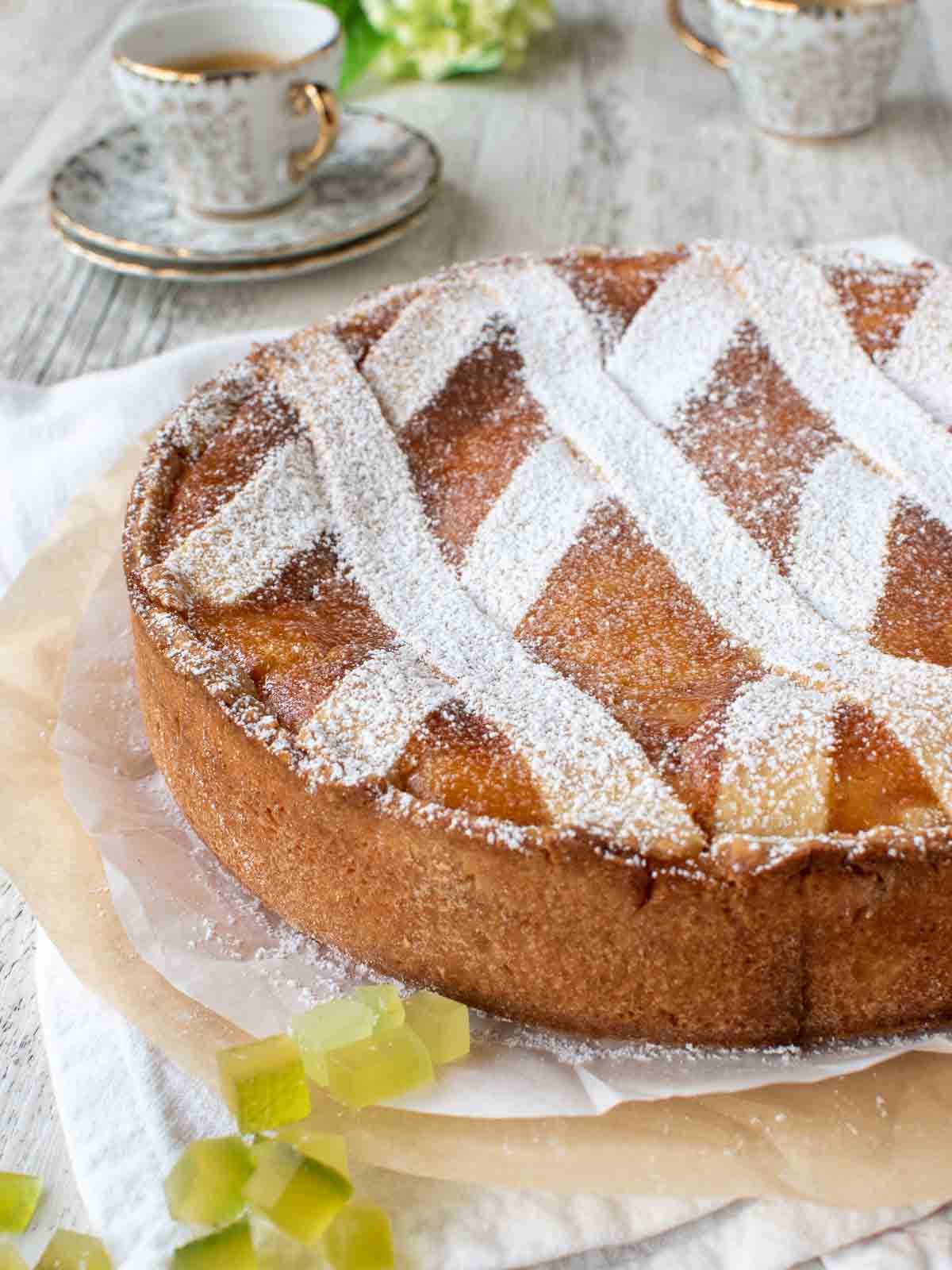
This updated and improved recipes was first published May 20, 2011.
Why you will love this recipe!
Easter lunch would not be complete in my house unless I’ve baked Pastiera, one of our favorite Italian desserts! On the table there might also be a flavorsome pizza gaina, roasted butterflied chicken with herbs, tasty Italian rice balls or a creamy tiramisu.
Pastiera Napoletana, as it’s also known, represents Easter to me and many other Italians. The tender crust is filled with a heady mixture of fragrance, texture and taste, this pie connects with all of your senses in the most wonderful way! First you’ll smell the tantalizing aroma of orange blossom. Then you notice the texture of the wheat berries but also the smoothness of the ricotta and finally the delicate but complex taste!
This is one of my favorite Easter recipes not just because of the taste but because of the meaning. Wheat is a symbol of resurrection being that it is buried and then emerges from the ground. Eggs symbolize birth and fertility. While the scent of orange blossoms fill the air in the Neapolitan gardens at Easter time. And all together this pie is amazing!
If you’re not familiar with this traditional Neapolitan recipe, you may be very curious about one particular ingredient – wheat berries. Wheat berries are whole wheat kernels without the husk. In years gone by, these would be soaked and cooked until tender. However today we can buy the cooked grain (grano cotto) in jars from Italian food stores or online, making the whole process a lot easier!
You will love Pastiera because, like my Torta della Nonna, it uses delicious pasta frolla – Italian shortcrust pastry. My recipe is very forgiving! Tradition dictates that the pie should be made at least 3 days before serving which is handy when you have other baking and preparations over the holiday period. As well, each component can be made separately in advance. During this time the flavors will develop and improve.
Table of Contents
Ingredients
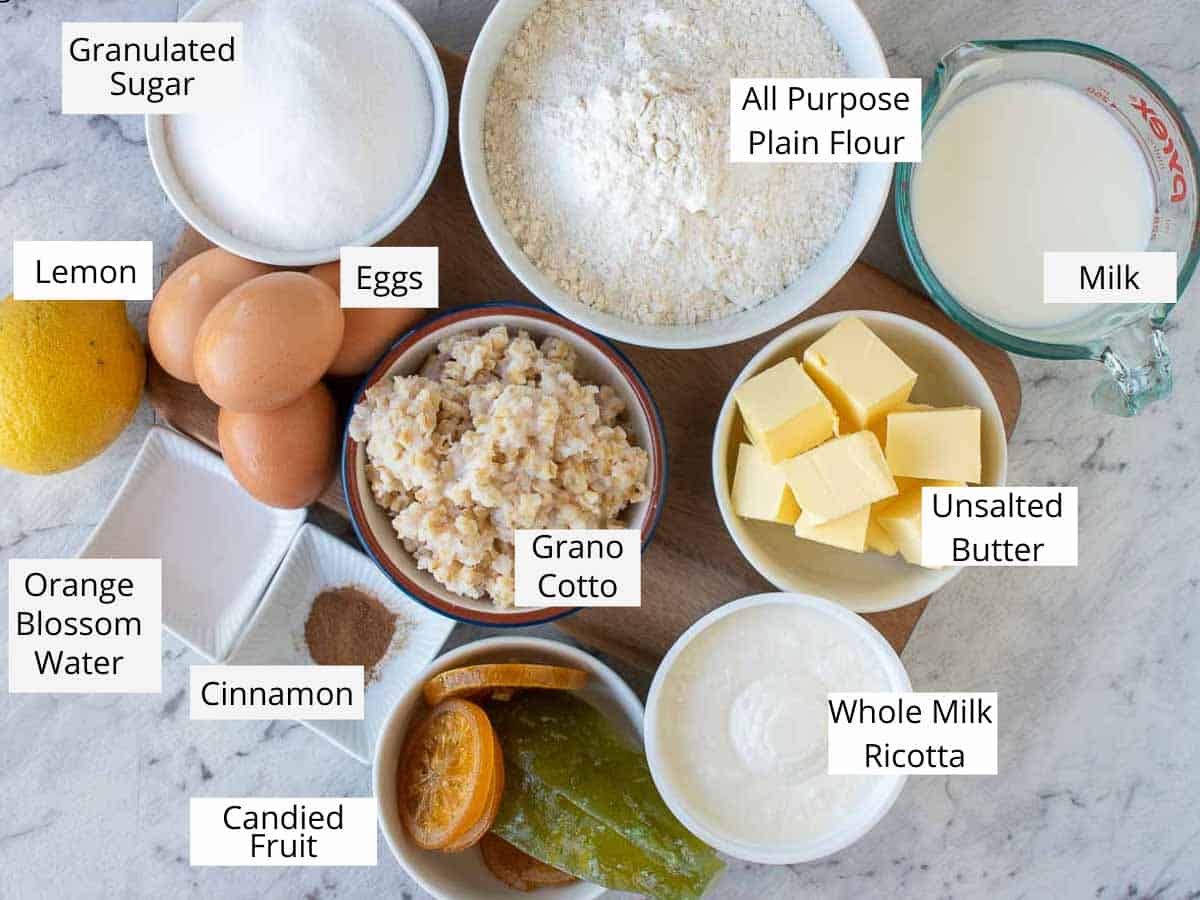
Some of these ingredients are not going to be available in most supermarkets so you may need to track them down in speciality stores. Alternatively I have provided substitutions for difficult to find ingredients.
- All purpose plain flour – For a tender crust use a flour that has a low protein content. You could seek out a pastry and cake flour which can have between 6-10% protein. Generally I just use regular all purpose plain flour. As always, be sure to measure it correctly by stirring the flour first to loosen it then spoon it into the cups without packing the flour in. Use the edge of a knife to level it off. Alternatively use scales for accurate measurements.
- Butter – Unsalted butter is my preferred butter for recipes. You’d be surprised how much salt is in salted butter and what a difference it makes in a recipe. However if you only have salted butter, use that but don’t add any extra salt to the pie dough.
- Granulated white sugar – Superfine white sugar is what I like to use but you can use regular white sugar. I like superfine (also known as castor sugar) because it dissolves much more readily.
- Eggs – You’ll need 5 eggs for the entire recipe so it’s a good idea to use the best quality you can afford. Free range eggs are a good choice.
- Grano cotto – As I mentioned above, this is cooked wheat that can be purchased in jars at good Italian food stores or online. Wheat berries (whole wheat kernels) can be soaked and boiled in water until soft if you can’t find the precooked grano cotto. Also I have made a version using rice cooked in milk (similar to rice pudding) instead of the grano cotto. (see Variations)
- Whole milk – If you only have low fat milk, that will be fine but we’re not counting calories when we eat desserts!
- Lemon – From one lemon, you need to take a 3 inch (7.5 centimeters) strip of zest to flavor the grano cotto and the rest of the zest is finely grated for the pie dough. Save the juice to squeeze over Italian chicken cutlets or to add to a raspberry compote.
- Whole milk ricotta cheese – Truthfully, low fat ricotta cheese won’t give you the same creaminess and smoothness that whole milk ricotta cheese will.
- Italian candied fruit – This can be one type or a mixture. I like to use candied citron and candied orange peel or slices. If you can’t find or don’t like any candied fruit, use 2 or 3 teaspoons of finely grated orange zest.
- Orange blossom water – Also known as orange flower water, the fragrance this give is essential to Easter Pastiera. You can find it at specialty import shops, the Middle Eastern section of the supermarket or online. It’s deceptively powerful so measure it carefully – it can overpower other ingredients. If you can’t track it down, use a couple of drops of orange oil or essence. It’s not quite the same but it will still produce a delicious and fragrant Easter cake.
- Vanilla extract – It’s best to use extract or paste but not vanilla essence because it’s not as flavorsome.
- Cinnamon – Ground cinnamon is optional. I like it but it’s not always added. I’ll leave it up to you.
Variations
Can’t find any grano cotto? No problem! I’ve got you covered with this variation – Italian Rice Pie!
Grano cotto (cooked wheat berries) can be hard to find but Pastiera with rice – Pastiera di riso – is also delicious. Some say it’s better. You can be the judge!
Use this cooked rice mixture instead of the grano cotto in the first step. Allow it to cool and add to the beaten sugar and ricotta mixture then continue with the recipe.
- To make the rice substitute for grano cotto, in a medium saucepan, bring to boil ¾ cup arborio rice with 2 cups of whole milk and a strip of lemon zest.
- When boiling, turn the heat down to a simmer. Cook gently until the milk is absorbed and the rice is creamy and thick.
- Remember to stir it regularly to prevent sticking and burning of the bottom.
- Remove the lemon zest and let it cool down completely. Spread it onto a plate to cool it more quickly.
Instructions
There are several parts to prepare for this recipe.
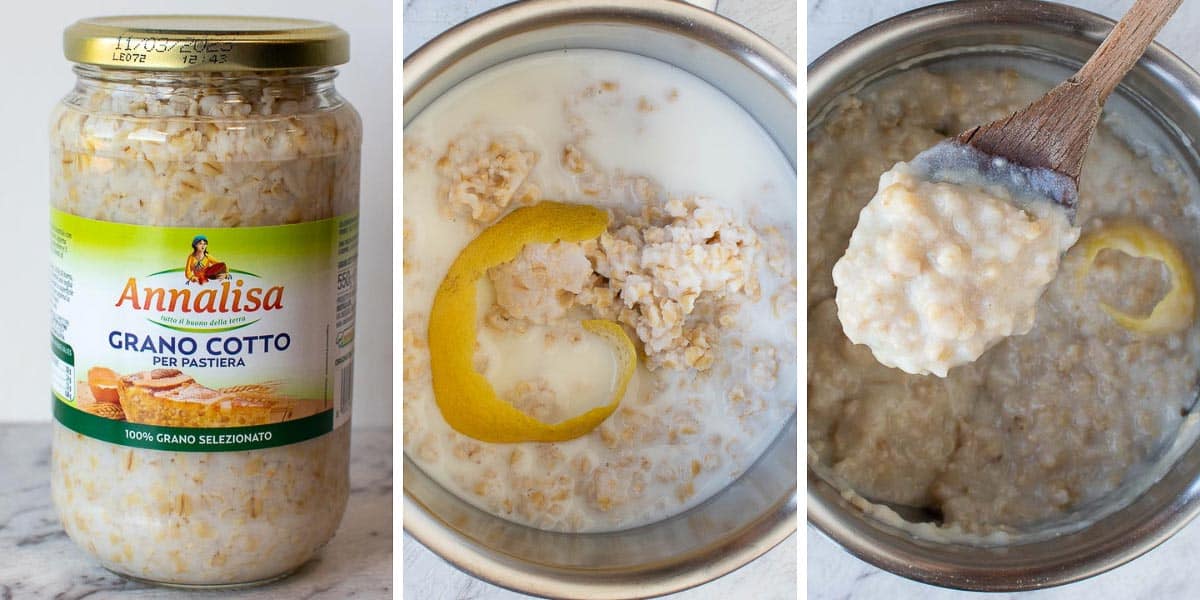
The first part to prepare is the grano cotto.
- Cooked grano cotto is available in jars from Italian import stores or online. This recipe uses half of the jar pictured. Double the recipe (using a full jar of grano cotto) and make two pies.
- Combine the grano cotto, milk and strip of lemon zest in a saucepan.
- Cook until thick and creamy.
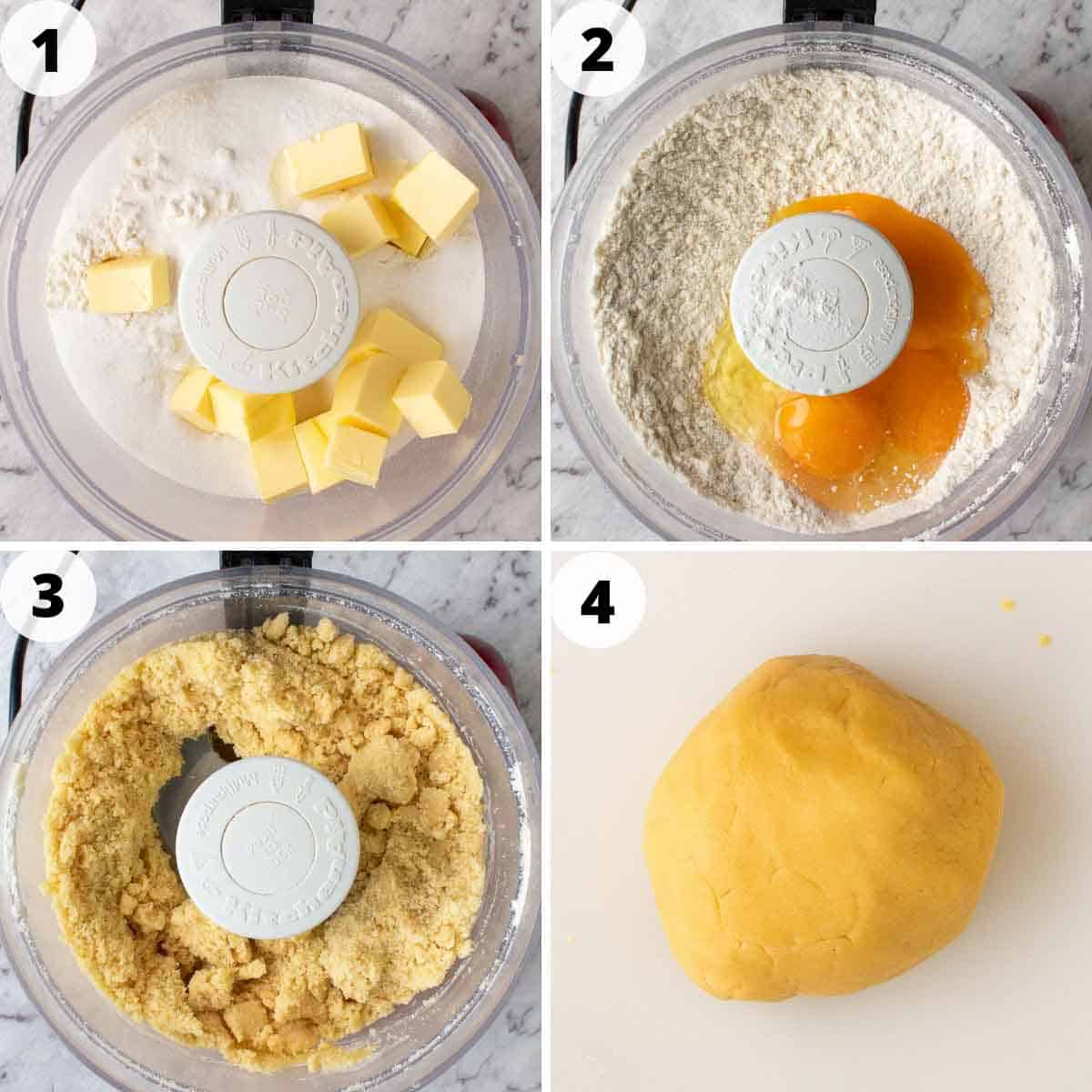
Secondly, prepare the pastry dough in the food processor.
- Place the flour, butter, sugar, lemon zest and salt in the food processor and pulse until the mixture is crumbly.
- Add egg and egg yolks.
- Process until the dough gathers together.
- Press into a ball, wrap in plastic and chill.
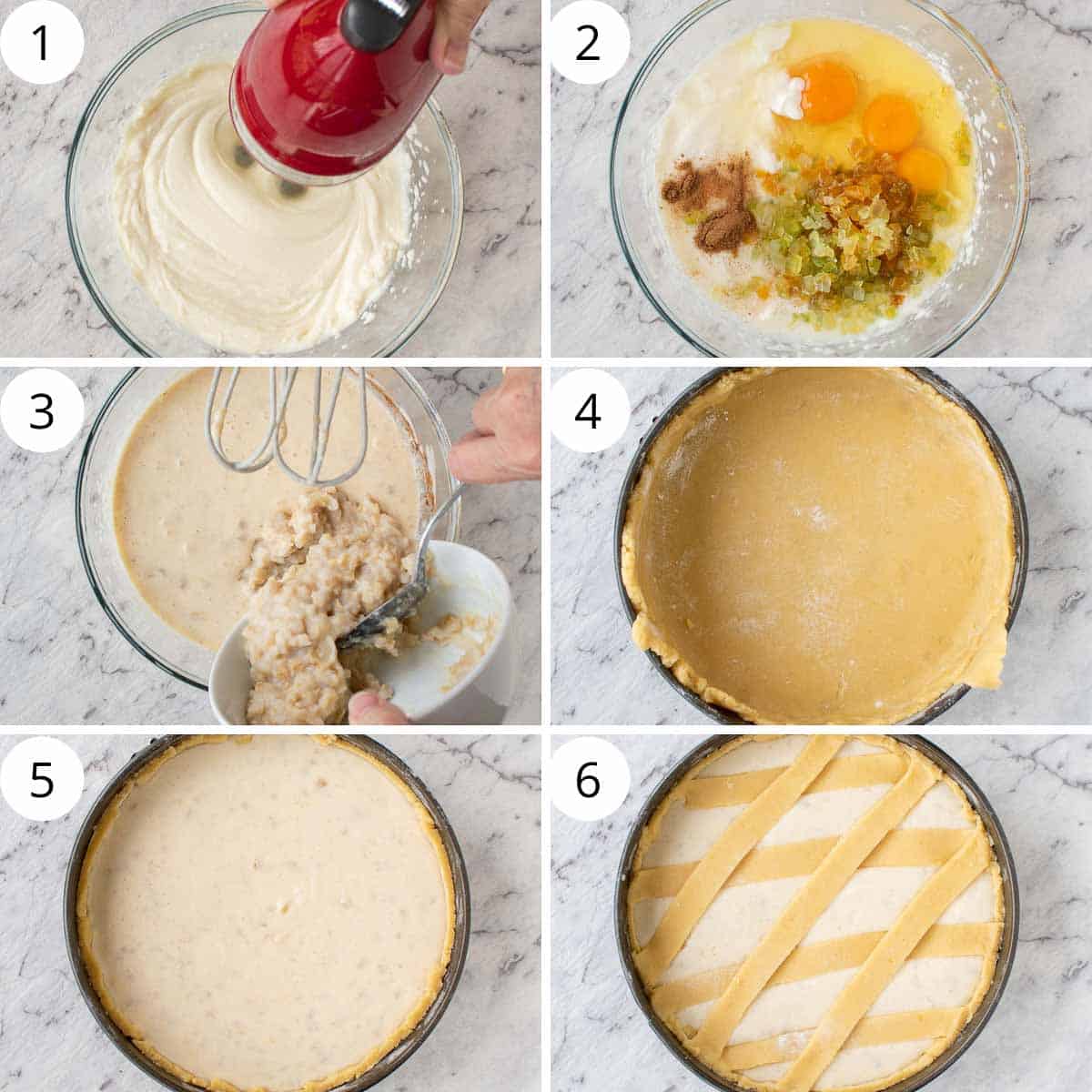
Finally, make the filling and assemble the pastiera. Heat the oven to 375°F/180°C.
Butter and line the base of a 9 inch/23cm springform cake pan or high sided pie pan.
- Beat ricotta and sugar in a large bowl.
- Add eggs, candied fruit, orange blossom water and cinnamon.
- Finally mix in the cooled grano cotto and set the filling aside.
- Roll out ⅔ dough and use it to line the prepared pan.
- Pour the ricotta mixture into the base.
- Decorate with strips of dough before baking. Bake until golden brown.
Tips for Success and FAQ’s
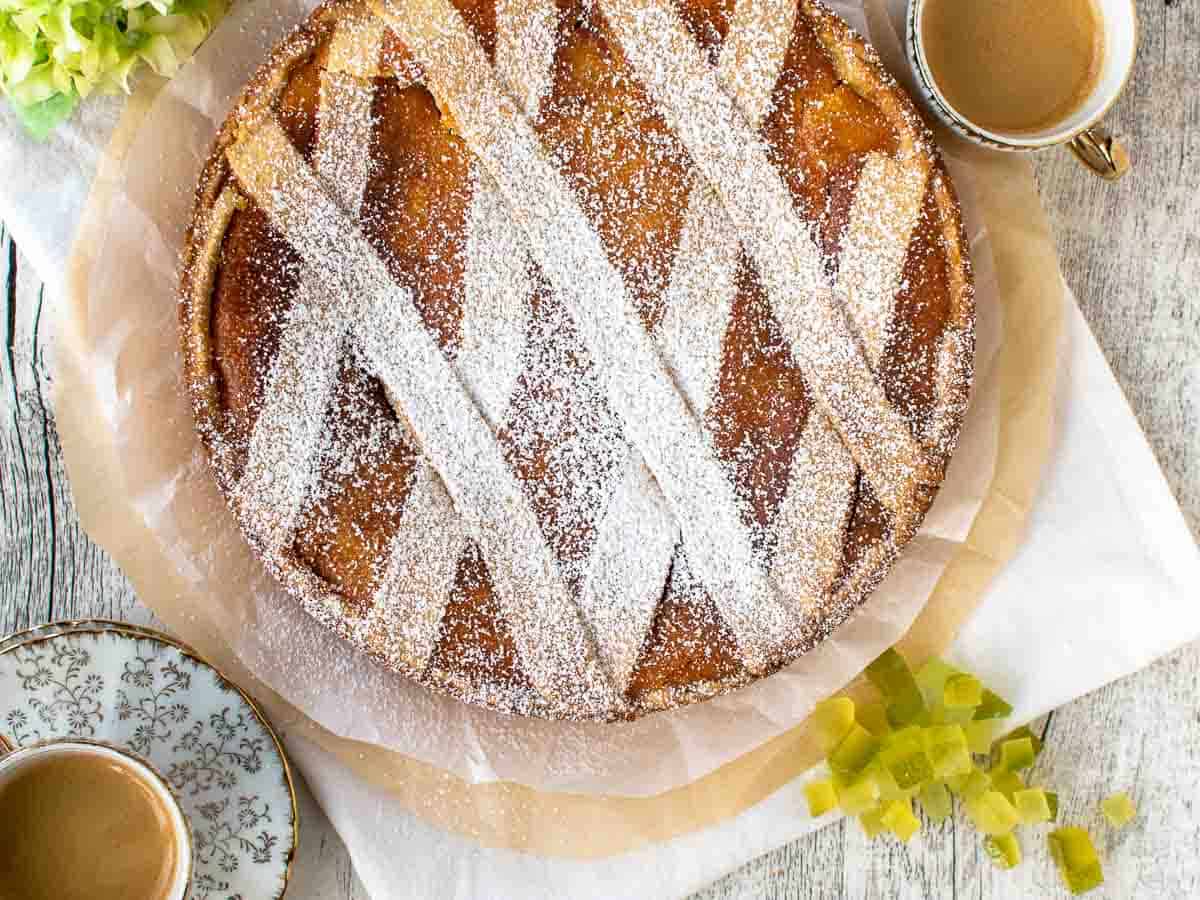
Pastiera is not difficult but there are several components. To make this recipe, planning ahead will help. Both the grano cotto for the filling and the pie dough can be made the day before baking and stored in the fridge covered with plastic wrap.
Gather all the ingredients before you start so that you’re not going back and forth to the fridge or pantry. If you have prepared the pie dough the day before, it may need to be removed from the fridge 10 minutes before rolling to soften slightly.
If you don’t have a food processor, chop the cold butter into small pieces then rub into the flour until the mixture is crumbly. Stir in the sugar, lemon zest and salt then add eggs to form a dough. Proceed with the recipe.
This pastiera recipe uses half of a 19 ounce (550 gram) jar of grano cotto pictured above. The remainder can be frozen for later. To use the whole jar, double the recipe and make two separate pies.
Pastiera originated in Naples, Italy. There are a few legends about the creation of Pastiera Napoletana that include offerings to a mermaid. But it’s likely that it was first made in a convent by nuns to celebrate the joyous occasion of Easter. The ingredients are important and well chosen and Pastiera is now synonymous with this Christian tradition all over Italy.
You can easily learn how to say Pastiera by breaking it up into words and sounds you know like this – “pass-tee-air-ra”.
If you are serving the pastiera the day it is baked, keep it at room temperature. However, after that it needs to be stored in the refrigerator covered in plastic wrap. Bringing the pastiera back to room temperature before serving is ideal. It will keep in the fridge for 5-7 days.
Yes, if you have leftovers you can freeze slices of well wrapped pastiera. To thaw, leave out at room temperature. Don’t thaw in the microwave
Serving Suggestions
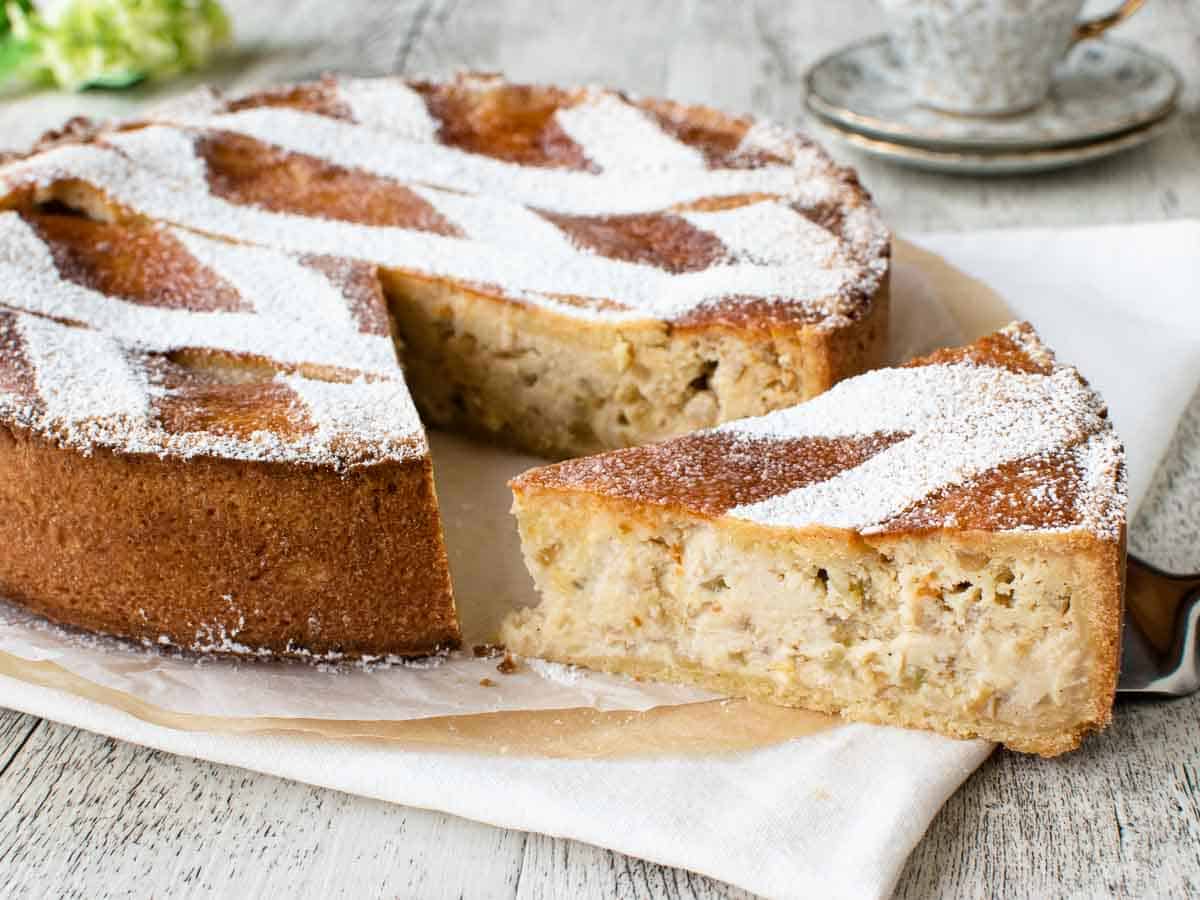
Pastiera Napoletana ideally should be served the day after baking to allow the flavors to develop. This is an Easter pie that is excellent served with just a dusting of powdered sugar and a cup of good Italian coffee. Leftovers make a wonderful breakfast or snack.
More recipes like this
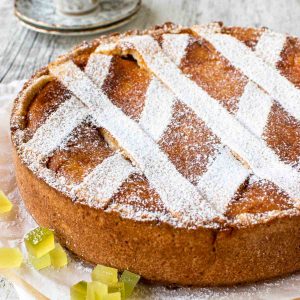
Pastiera Napoletana Recipe
Ingredients
Grano Cotto
- 9¾ ounces (275 grams) grano cotto See Note 1
- ¾ cup (177 millilitres)whole milk
- strip of lemon zest about 3 inches (7.5cm) long
Pastry Dough (Pasta Frolla)
- 2¼ cups (280 grams) all purpose (plain) flour plus extra for dusting
- 5 oz (1¼ sticks/140 grams) cold unsalted butter chopped
- ½ cup (100 grams) granulated white sugar or caster sugar
- 2 teaspoons finely grated lemon zest
- pinch of salt
- 1 egg
- 1 egg yolk
Filling
- 16 ounces (500 grams) whole milk ricotta cheese See Note 2
- 1 cup (200 grams) superfine (castor) sugar
- ⅔ cup chopped mixed Italian candied fruit See Note 3
- 3 eggs
- 1 tablespoon (15 millilitres) orange blossom water orange flower water
- 1 teaspoon (5 millilitres) vanilla extract
- ½ teaspoon ground cinnamon optional
Instructions
For the Grano Cotto
- Place the grano cotto, milk and strip of lemon zest in a saucepan and cook gently over a low heat stirring regularly, for about 30 minutes or until the mixture is thick and creamy. Spread out onto a plate to cool.
For the Pastry Dough (Pasta Frolla) – using a food processor
- Place the all purpose flour, butter, sugar, lemon zest and salt in the food processor bowl. Pulse until crumbly.
- Then add the egg and egg yolk and process until the mixture gathers into a ball.
- Remove from the bowl, flatten into a disk and wrap in plastic wrap. Refrigerate while you prepare the rest of the filling.
For the Filling
- In a large bowl, beat the ricotta and sugar with an electric mixer or by hand until smooth and creamy.
- Add eggs, candied fruit, orange blossom water and cinnamon (if using). Mix well.
- Finally add cooled grano cotto mixture and beat gently to combine. Set aside while you roll out the dough.
To Assemble and Bake
- Heat the oven to 375°F/180°C.
- Butter and line the base of a 9inch/22.5cm springform cake pan or high sided pie pan.
- Remove the pastry dough from refrigerator and divide into two pieces – ¾ and ¼. Take the larger piece. Press it down to flatten and form a rough circle. Dust the pastry lightly with flour.
- Roll out the larger piece between two pieces of nonstick parchment until large enough to fit the base and sides of the prepared pan. If the pastry is sticking, dust it with a little flour. The pastry will only need to reach about 2 inches (5 centimeters) up the sides of the 9 inch (23-centimeter) springform cake pan.
- Carefully wind the pastry around the rolling pin then unroll into the prepared pan. Carefully lift and ease the pastry in to line the base and up the sides. Just patch any tears or holes – this pastry is very forgiving.
- Scrape in the ricotta mixture and level. Cut away any excess dough just above the filling and reserve the pastry dough.
- Press the remaining dough together with the excess then roll out between two pieces of nonstick parchment. Cut into strips to fit the top of the tart. You'll need 7 strips – 4 in one direction and 3 in the opposite direction.
- Bake in the preheated oven for about 50-60 minutes until golden brown. It may take longer to become golden brown, depending on your oven. The pastiera will puff slightly and will have browned on the surface.
- Allow to cool completely. It will flatten on the surface as it cools.
- The pastiera can be served at room temperature or chilled. Dust with powdered (icing) sugar before serving.
- Pastiera will keep in the fridge for 5-7 days.
Notes
- Grano cotto is cooked wheat that you can buy in jars or cans from Italian import stores.
- If you can’t find grano cotto, substitute it with this cooked rice “pudding”. In a medium saucepan, boil ¾ cup of arborio rice, 2 cups of whole milk, and a strip of lemon zest. Once boiling, turn the heat to simmer until the rice is creamy, thick and tender. Stir regularly. Discard the lemon peel, scrape onto a plate, and cool completely before adding to the beaten sugar and ricotta mixture in Step 3 under “Filling”.
- Drain the ricotta cheese overnight if it’s watery. Make homemade ricotta cheese with my easy recipe.
- For the Italian candied fruit, you can use just one type or a mixture. I usually use a mixture candied citron and candied orange peel or slices. Substitute 2 or 3 teaspoons of finely grated orange zest if you can’t find or don’t like candied fruit.
- Plan ahead and make the grano cotto and dough in advance
- Gather all the ingredients before you start so that you’re not going back and forth to the fridge or pantry.
- No food processor? No problem! Check the instructions above for how to make by hand.
Nutritional Estimate Per Serving
Nutritional Disclaimer
Nutritional information is an estimate provided by an online nutrition calculator. For accurate results, it is recommended that the nutritional information be calculated based on the ingredients and brands you use.

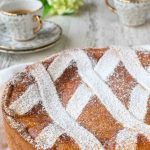

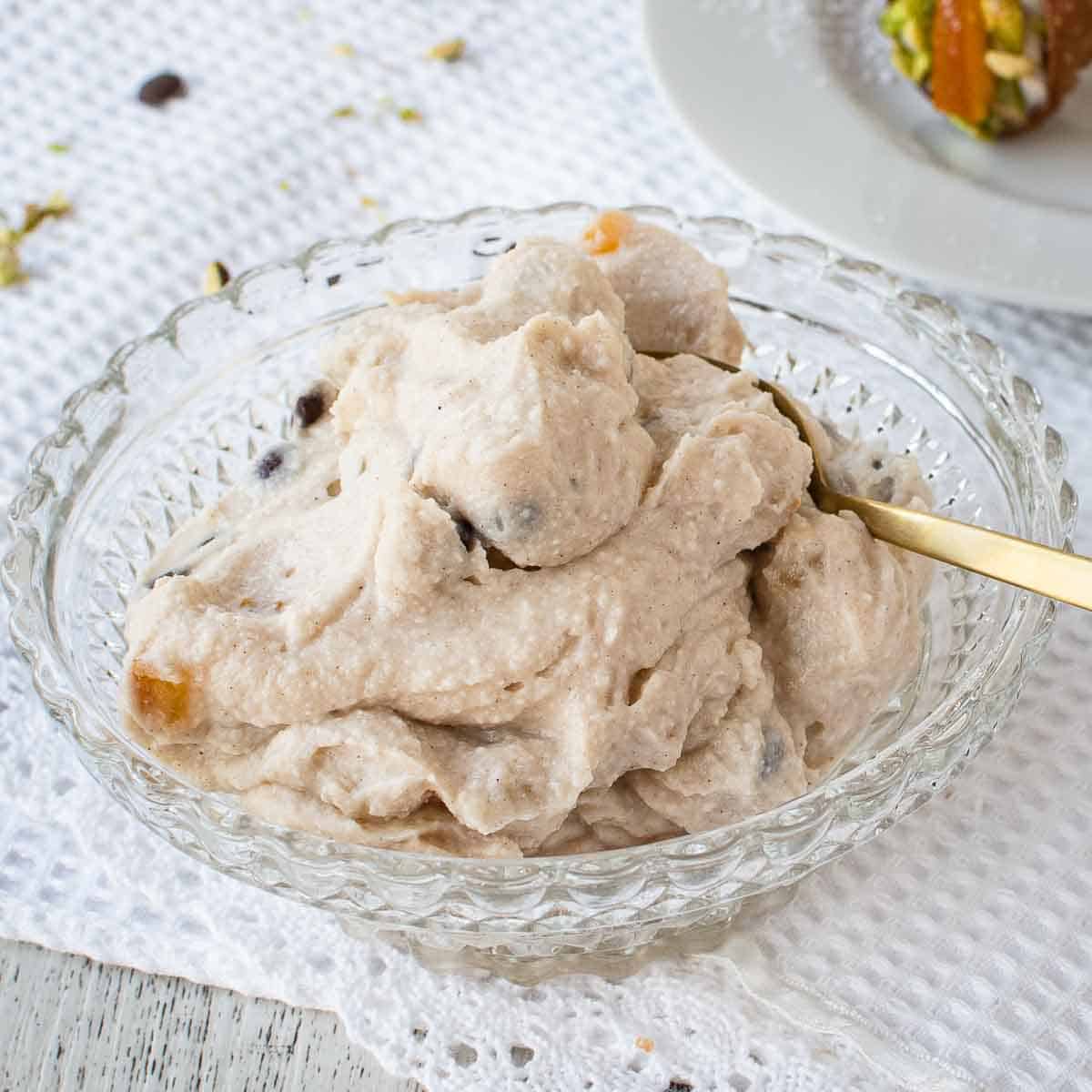
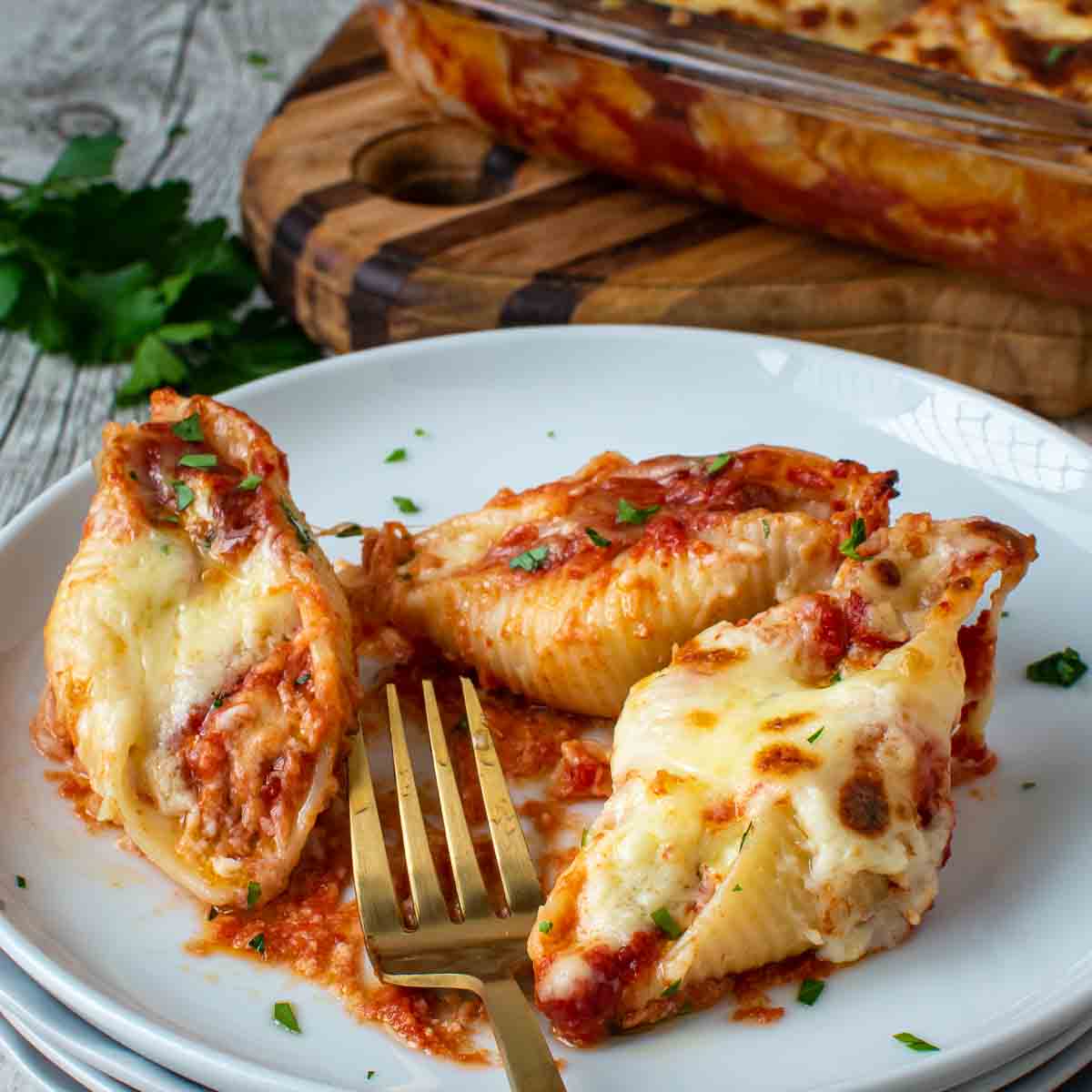
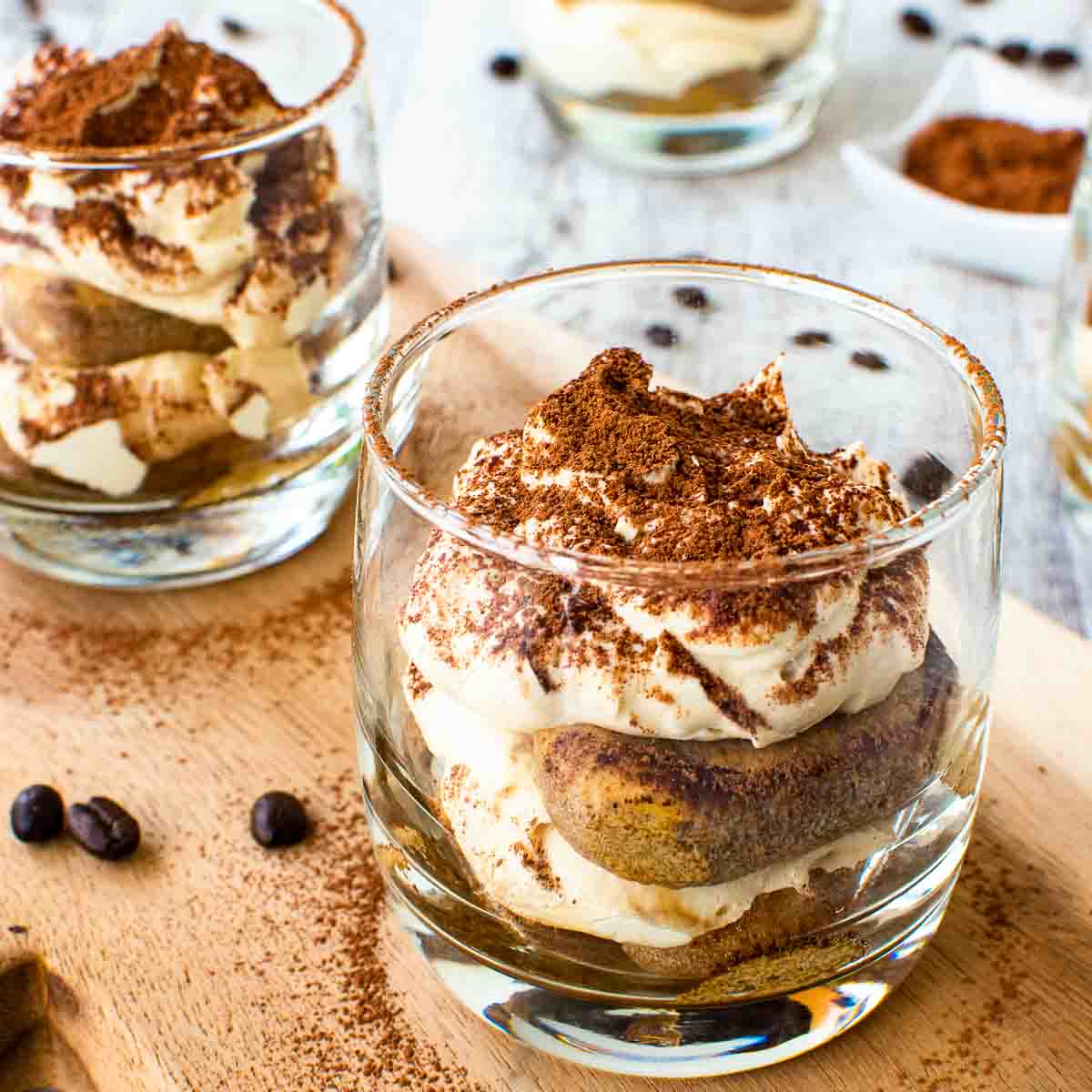
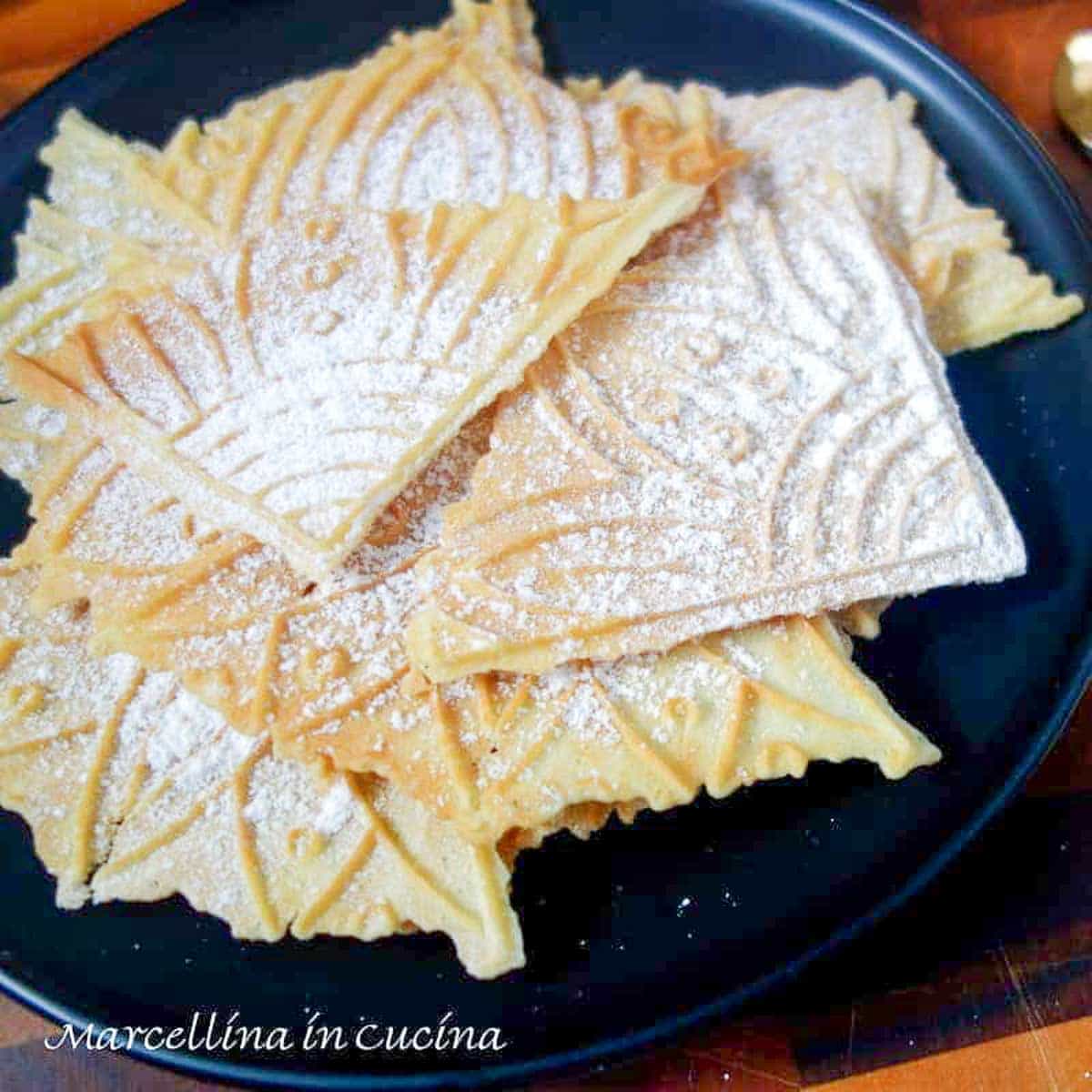
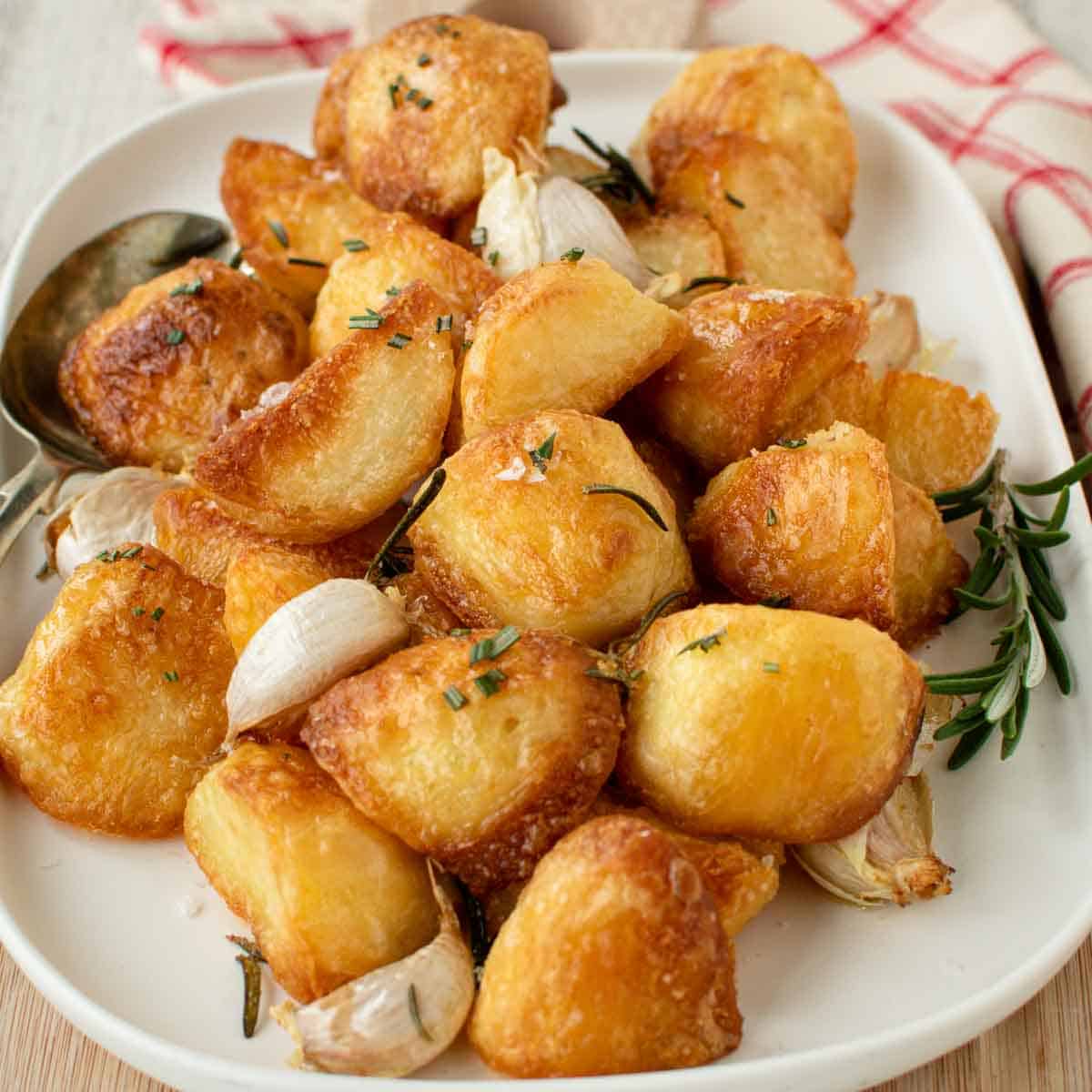
I’ve been wanting to make this for years and finally did it. Your recipe was perfect. The pasta frolla has amazing flavor. There were so many recipes to choose from and some said lemon peel, some orange so I used a little of both. Nice citrus flavor. No candied fruit in mine but the texture was great. I’m wondering how well this would freeze. Thank you for your recipe that brought back many family gathering memories.
Nancy, I’m pleased that you enjoyed your pastiera! Yes, it does freeze quite well. The texture may change very slightly but I freeze this quite often…not this year as we finished ours in no time.
hiya. in UK. What is 2 cups of milk and 3/4 cup of arborio in grammes for the grano cotto substitute? thank you! Buona Pasqua!
Anthony, 2 cups of milk is 460 grams and 3/4 cup arborio is 143 grams. Buona Pasqua!
Grazie mille. I lived in napoli for about 5 years and fell for pastiera. I always make one at Easter but I wanted to do one with rice not barley (cannot get grano cotto here). Yours seems best recipe. Will let you know. buone pasta e buona pasquetta! Anthony.
You’re welcome, Anthony! I’ve just made mine with grano cotto but I used to make it with rice because I couldn’t get grano cotto. It’s quite a good variation. Buona Pasqua!
If using rice, how much and what type of rice is best?
Chuck, to make the rice substitute for grano cotto, in a medium saucepan, bring to boil ¾ cup arborio rice with 2 cups of whole milk and a strip of lemon zest.
When boiling, turn the heat down to a simmer. Cook gently until the milk is absorbed and the rice is creamy and thick.
Remember to stir it regularly to prevent sticking and burning of the bottom.
Remove the lemon zest and let it cool down completely. Spread it onto a plate to cool it more quickly.
Use this cooked rice mixture instead of the grano cotto in the first step. Allow it to cool and add to the beaten sugar and ricotta mixture then continue with the recipe.
If using rice, how much and what type of rice?
Johann, to make the rice substitute for grano cotto, in a medium saucepan, bring to boil ¾ cup arborio rice with 2 cups of whole milk and a strip of lemon zest.
When boiling, turn the heat down to a simmer. Cook gently until the milk is absorbed and the rice is creamy and thick.
Remember to stir it regularly to prevent sticking and burning of the bottom.
Remove the lemon zest and let it cool down completely. Spread it onto a plate to cool it more quickly.
Use this cooked rice mixture instead of the grano cotto in the first step. Allow it to cool and add to the beaten sugar and ricotta mixture then continue with the recipe.
I finally made this yesterday. (We’re not home for Easter.) And it was a big hit! It tastes/feels like a delicious combo of cheescake and rice pudding, with just the right level of sweetness.
Next — and that will be pretty soon, as we and some friends have eaten nearly all of it during the first day! — I’ll try to make a stiffer dough, and use more flour dusting and cycle it in/out of the fridge while trying to remove it from the paper and put it in place. It was so soft (especially when thin) that it just fell apart. I just pressed the bottom & sides into the pan, and it worked out fine. The top strips sank into the filling. I may drain the grano cotto next time. (I used the full jar, too … didn’t read the directions as fully as I should. But I liked it, so I may do the same with more candied fruit. There was plenty of room in my springform pan. I’ll also cook it longer. I was afraid of burning the top, but didn’t come as close as I’d feared. When it was cool, even the middle was solid enough to cut. I’m surprised this is not on more Italian restaurant menus. Thanks for introducing this to me.
I’m so glad you enjoyed this, Mike! It’s possible that you had a few issue because you use a full jar of grano cotto instead of just half. Also be sure to drain the ricotta if it’s wet. Yes, it can take a lot more baking that you think. I’m thrilled that this was new to you and you loved it!
We made this from the desire for the traditional Easter dessert of our childhood, but the family has many American children who will not eat anything with traditional candied fruit pieces. We made recipe as is but replaced the citrons with mini chocolate chips. The pie was a big hit. Also, very important, make it a day ahead and let the the ingredients settle. so much better after everything melds together in the refrigerator. Will try making with rice next time.
I’m glad you were able to adapt this traditional recipe to appeal to the tastes of American children. The chocolate chips are a great idea! Buona Pasqua!
Just made one yesterday coz my brother buys local commercial ones that pale. I found canned cotto grano at Chelsea Market in Manhattan.
one of our faves, along with cassetedde (asa cassetelle) and almond biscotti.
In Nov, Fairway and sometimes WF have fresh Californian citron, to DIY.
But could I use farro instead of wheat berries or rice?
Would they prep be the same?
Hello Fritz, yes, you can use farro though I’ve never done it myself. I have only made the grano cotto and the rice version but the principal is the same. Cook the farro gently in milk until softened and tender. Add the strip of lemon zest towards the end of the cooking. You will likely need to add more milk or you could add water during the cooking as the milk is absorbed. For this recipe use about 1/2 cup to 3/4 cup of uncooked farro.
I have used farro with great results. I would even say that I now prefer it to the wheat berries.
That’s good to know, Kimarie!
This pie looks so interesting!
I’ll be late for this Easter, as I had to buy a bottle of Grano Cotto online. (None of the Italian markets in my area knw of it.) It has some liquid in it, as well as the cooked wheat grain. Should I drain off this liquid before using it in the recipe … or include the liquid?
Mix the liquid in, Michael. Enjoy!
Yum! I love pastiera. And it wouldn’t feel like Easter without it. Only I probably won’t have one this year, sadly. Long story… And speaking of stories, I hadn’t heard the one about the mermaid, I’ll need to look into that one!
Anyway, your pastiera looks delicious. Buona Pasqua!
Thank you, Frank! I’m sorry you won’t have a pastiera this year – I know you make a good one! Buona Pasqua!
I have a similar recipe that uses fine semolina in the recipe. It is a recipe that has been passed down to my aunt and I continue to make it every Easter . It is an excellent! Some of my children and grandchildren likes this better than my Easter Rice Pie.
That sound interesting, Rosaleen! I think it’s so important to keep our family recipes alive.